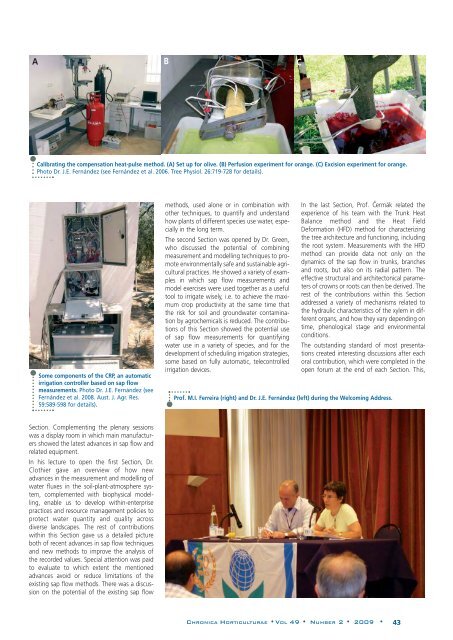Chronica Horticulturae volume 49 number 2 ... - Acta Horticulturae
Chronica Horticulturae volume 49 number 2 ... - Acta Horticulturae
Chronica Horticulturae volume 49 number 2 ... - Acta Horticulturae
You also want an ePaper? Increase the reach of your titles
YUMPU automatically turns print PDFs into web optimized ePapers that Google loves.
A<br />
B<br />
C<br />
Calibrating the compensation heat-pulse method. (A) Set up for olive. (B) Perfusion experiment for orange. (C) Excision experiment for orange.<br />
Photo Dr. J.E. Fernández (see Fernández et al. 2006. Tree Physiol. 26:719-728 for details).<br />
Some components of the CRP, an automatic<br />
irrigation controller based on sap flow<br />
measurements. Photo Dr. J.E. Fernández (see<br />
Fernández et al. 2008. Aust. J. Agr. Res.<br />
59:589-598 for details).<br />
methods, used alone or in combination with<br />
other techniques, to quantify and understand<br />
how plants of different species use water, especially<br />
in the long term.<br />
The second Section was opened by Dr. Green,<br />
who discussed the potential of combining<br />
measurement and modelling techniques to promote<br />
environmentally safe and sustainable agricultural<br />
practices. He showed a variety of examples<br />
in which sap flow measurements and<br />
model exercises were used together as a useful<br />
tool to irrigate wisely, i.e. to achieve the maximum<br />
crop productivity at the same time that<br />
the risk for soil and groundwater contamination<br />
by agrochemicals is reduced. The contributions<br />
of this Section showed the potential use<br />
of sap flow measurements for quantifying<br />
water use in a variety of species, and for the<br />
development of scheduling irrigation strategies,<br />
some based on fully automatic, telecontrolled<br />
irrigation devices.<br />
In the last Section, Prof. Čermák related the<br />
experience of his team with the Trunk Heat<br />
Balance method and the Heat Field<br />
Deformation (HFD) method for characterizing<br />
the tree architecture and functioning, including<br />
the root system. Measurements with the HFD<br />
method can provide data not only on the<br />
dynamics of the sap flow in trunks, branches<br />
and roots, but also on its radial pattern. The<br />
effective structural and architectonical parameters<br />
of crowns or roots can then be derived. The<br />
rest of the contributions within this Section<br />
addressed a variety of mechanisms related to<br />
the hydraulic characteristics of the xylem in different<br />
organs, and how they vary depending on<br />
time, phenological stage and environmental<br />
conditions.<br />
The outstanding standard of most presentations<br />
created interesting discussions after each<br />
oral contribution, which were completed in the<br />
open forum at the end of each Section. This,<br />
Prof. M.I. Ferreira (right) and Dr. J.E. Fernández (left) during the Welcoming Address.<br />
Section. Complementing the plenary sessions<br />
was a display room in which main manufacturers<br />
showed the latest advances in sap flow and<br />
related equipment.<br />
In his lecture to open the first Section, Dr.<br />
Clothier gave an overview of how new<br />
advances in the measurement and modelling of<br />
water fluxes in the soil-plant-atmosphere system,<br />
complemented with biophysical modelling,<br />
enable us to develop within-enterprise<br />
practices and resource management policies to<br />
protect water quantity and quality across<br />
diverse landscapes. The rest of contributions<br />
within this Section gave us a detailed picture<br />
both of recent advances in sap flow techniques<br />
and new methods to improve the analysis of<br />
the recorded values. Special attention was paid<br />
to evaluate to which extent the mentioned<br />
advances avoid or reduce limitations of the<br />
existing sap flow methods. There was a discussion<br />
on the potential of the existing sap flow<br />
CHRONICA HORTICULTURAE •VOL <strong>49</strong> • NUMBER 2 • 2009 • 43
















